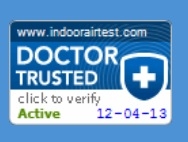News
Chemical, Biological and Radiological (CBR) Pollutants of Indoor Environments
CBR related issues of the indoor environment may occur/induce due to a number of activities within the building or as a result of outside infiltration or the combination of both.
According to the US Environmental Protection Agency (EPA/400/1-89/001C), Americans spend 90% of their time indoors. The indoor environment becomes a concern when it gets contaminated due to Chemical, Biological and Radiological (CBR) agents. The monitoring of indoor environments becomes necessary in order to evaluate and manage the health and hygiene around the area. This distresses everyone to some extent, but it is particularly harmful to residents around metropolitan areas with large industrial settings, children whose immune systems/immunity are/is still developing, the elderly with known medical conditions and of course, people with compromised immune systems.
The Sources of CBR Contaminants
CBR related issues of the indoor environment may occur/induce due to a number of activities within the building or as a result of outside infiltration or the combination of both. Some common and frequent CBR agents/of the indoor environment is described below:
Chemical Agents: Various chemicals of inorganic and organic nature are listed as common contaminates of indoor environments. The products of combustion (oil, gas, kerosene, coal, wood, tobacco products and others), building materials and furnishings, insulating materials, household cleaning supplies, heating or air-conditioning ventilation systems, gardening supplies, microbial or biological decomposition or degradation of indoor materials are some of the common and important examples of potential sources of chemical pollutants. Volatile organic compounds, acetone, alcohols, carbon monoxides, carbon dioxides, methane, sulfur compounds, formaldehyde, amines, ozone, xylene, chlorine, and several other metallic and non-metallic acid and base compounds are documented as indoor air contaminants/pollutants.
Biological Agents: A diversified group of both macro and microorganisms, besides their byproducts (i.e. exotoxins, endotoxins, mycotoxins etc.), are reported as indoor contaminants. These organisms originate from animal, plant and microbial sources. Viruses, mycoplasma, bacteria, protozoa, algae, fungi/mold, cysts, spores, pollen grains, insects, mites, danders, trichomes, hairs, feathers and other particulates of biological origin as well as the byproducts of animal, plant and microbial origin are identified as potential bio-contaminants of indoor environments. These agents can be mesophiles, thermophiles or psychrophiles based on their growth behaviors in relation to the temperature.
Radiological Agents: The bulk of radiological agents in indoor environments come from the accumulation of radiation from naturally occurring radioactive materials such as uranium, thorium and radon etc. The most significant source of radioactive material in the indoor environment is radon. Radon comes from the decay of radium; a radioactive element naturally found in soil; however, its concentration is variable. Radon in the air can further decay into radioactive polonium, a potentially harmful substance and carcinogen. The buildings around a nuclear facility, power plants operated with radioactive materials, and laboratories dealing with radioactive materials are more vulnerable to radiological contamination.
CBR Contamination and Health & Hygiene
CBR contamination is a global problem due to its impact on health and hygiene. The potential risk of CBR contamination is not only linked to short-term exposure with acute symptoms, but can also lead to chronic health conditions from long-term exposure. The results of CBR contamination exposure can be as simple as minor skin or eye irritation to a more complex chronic respiratory disease, cardiovascular issues, or cancer. Some of these conditions can be treated with the supervision of medical professionals; however, in complex situations hospitalization is required, as some cases may be fatal.
According to a report by the World Bank (1994), a significant loss of life was noticed in developing countries due to indoor air quality. This is mainly linked to burning of wood or coal without proper ventilation. The US EPA Indoor Air Facts No.4 (Air and Radiation 6609 J, R& D (MD-56), February 1991) emphasizes the role of CBR in “Sick Building Syndrome.” In 2009, the WHO guidelines for indoor air quality summarized: “sufficient epidemiological evidence is available from studies conducted in different countries and under different climatic condition to show that the occupants of damp or mouldy buildings, both houses and public buildings, are at increased risk of respiratory symptoms, respiratory infections and exacerbation of asthma.” In a January 2005 news release, the U.S. Surgeon General, Richard H. Carmona, noted that radon is the second leading cause of lung cancer in the United States, with more than 20,000 Americans dying each year from radon-related lung cancer. Only smoking causes more lung cancer related deaths and smokers exposed to radon are at an even higher risk than nonsmokers.
Monitoring and Management of CBR Contaminants
Periodical environmental monitoring is essential to the identification and management of CBR contaminants in indoor environments. In recent years, a number of technologies have become available to detect the presence of various chemical, biological and radiological contaminants. Simple “do-it-your-self” screen test kits are useful in the initial identification of CBR contaminants. Diagnostics for CBR contaminants start with the collection of the environmental samples, documentation of the complaints and symptoms of a building. Environmental samples are collected by sampling air, surface and liquids. These are then sent to a qualified environmental laboratory to be analyzed. After the identification of the contaminant/s, a detailed and cost effective investigation can be initiated on a professional consultant/industrial hygiene firm. Depending upon the findings, an appropriate control measure can be hypothesized. Remediation can be initiated should it require addressing the associated problems, if any.
For newer construction and existing buildings, CBR contamination related issues can efficiently and effectively be managed by drawing some attention. The following factors may be considered in the new construction of a building which can help to mitigate the risks of CBR contamination:
1. A tight building envelope
2. Installation of ventilation at relatively higher levels on building
3. Efficient designing of heating air conditioning ventilation system (HVAC)
4. Physical security of HVAC
5. Periodical monitoring of HVAC control system
6. Routine house keeping schedule
However, in existing buildings an appropriate modification in terms of the above mentioned factors is helpful. The United States Green Building Council initiated a program known as LEED (Leadership in Energy and Environmental Design) for commissioning for/of new and existing building which can also be helpful in the management of CBR contamination control.
About Environmental Diagnostics Laboratory (EDLab): Established in 1994, Environmental Diagnostics Laboratory (EDLab) is the industry leader of indoor environmental laboratory analytics under the direction of Dr. Rajiv Sahay, FAIS, CIAQP.
The parent company, Pure Air Control Services is a international environmental firm performing the following IAQ services: Building Sciences Evaluation; Building Health Check; EDLab an AIHA accredited Environmental Microbiology Laboratory, Environmental Project Management; and Mold Remediation Services, among other indoor environmental services.
The company’s expanding client roster includes: FAA, USACE, General Services Administration (GSA); Allstate Insurance; Carrier Air Conditioning; Naval Air Warfare Center, Orlando; and Naval Air Station - King's Bay, Georgia, Walt Disney World, and many other Fortune 500 companies, school boards, and city, state, and county governments, making Pure Air Control Services the reliable industry leader in IAQ.
For more information on EDLab, Pure Air Control Services, Inc. please contact Dr. Rajiv Sahay or Alan Wozniak at (800) 422-7873, or visit www.pureaircontrols.com.
.

More News

IAQ Test Kits (DIY), PURE-Steam Coil Cleaning and PURE-Decon Room Treatment Showcased at the Annual FRACCA Conference
This annual event provides an opportunity for licensed contractors throughout the State of Florida to obtain all 14 state-required hours of continuing education over the course of the two-day event.
Released On: 3/8/2014
Views: 4359

Free Legionella Webinar: Detection & Identification Workshop
Although this type of bacteria was around before1976, more illness from Legionnaires' disease is being detected now. Due to consumer awareness, added research and technological advances in healthcare Legionnaires disease identification is becomi ...
Released On: 3/4/2014
Views: 4214

Why Some High-Performance Buildings Are Failing?
Performance of a building depends on its structured integrity, preventive maintenance, as well as periodical monitoring of the environmental conditions essential for its functionality.
Released On: 2/19/2014
Views: 4245

Legionnaire’s – What You Should Know About The Potential Deadly Bacteria
According to Building Operating Management magazine, expert Victor Yu, MD, Professor of Medicine, University of Pittsburgh; Chief, Infectious Disease Section, VA Medical Center, Pittsburgh, PA, disclosed that “Up to 70% of all buildings greater t ...
Released On: 2/18/2014
Views: 3804

Managing of Indoor Environments: Problems and Solutions - IEQ WEBINAR
Released On: 1/22/2014
Views: 3702

Save Energy and Improve Indoor Air Quality (IAQ) with PURE-Steam Deep Coil Cleaning
High efficiency coils are extremely susceptible to blockage from dust accumulation because once lodged deeply within the fins bacteria and mold may initiate growth, which not only compounds the blockage problems but also gives rise to excessive o ...
Released On: 1/8/2014
Views: 6477

January is National Radon Action Month
Exposure to radon is the second leading cause of lung cancer after smoking. Radon is an odorless, tasteless and invisible gas produced by the decay of naturally occurring uranium in soil and water.
Released On: 1/8/2014
Views: 4137

Why indoor air quality is important to all of us?
World Health Organization (WHO Guidelines for Indoor Air Quality, 2009) concluded that the most important effect is increased prevalence of respiratory symptoms, allergies and asthma, as well as perturbation of the immunological systems
Released On: 12/31/2013
Views: 4193

Pure Air Control Services Launches New Interactive Website
The website is a true indoor environmental resource for the private and public sector including consumers, educational facilities e.g. schools, universities, along with city, county state and federal governments, healthcare and the public sector.
Released On: 12/20/2013
Views: 3190

Pure Air Control Services Awarded Certification from Doctor Trusted
“We are very proud to have been given the opportunity to display that we are a Doctor Trusted recipient. We will continue as always to help provide our customers with a great products and services,” stated Dr. Rajiv Sahay, environmental analytica ...
Released On: 12/11/2013
Views: 4138

IndoorAirTest.com Receives Seal of Approval by Doctor Trusted
IndoorAirtest.com is very proud to have a Doctor Trusted seal of approval displayed on our website, giving our customers more confidence when shopping with us.
Released On: 12/4/2013
Views: 4562

PURE-Decon/Sanosil, Reduces Sick Days Caused by Infection
Released On: 10/2/2013
Views: 3490

Controlling Asthma & Allergy Triggers Through Source Identification
The assessment of allergens in a house dust sample is an essential step for allergen-avoidance and provides information essential for allergen-reducing measures, in addition to managing the indoor environment from a health and hygiene point of view
Released On: 9/18/2013
Views: 5583

Hospitals Get a “Clean Bill of Health” with Innovative IAQ/Energy Solutions
Healthcare-associated infections (HAIs) are infections that patients acquire during the course of receiving healthcare treatment for other conditions.
Released On: 7/31/2013
Views: 4611

How Safe is Formaldehyde in our Buildings and Homes?
Released On: 7/17/2013
Views: 4882

Commercial Energy Solutions Seminar July 26, 2013
Released On: 7/11/2013
Views: 4937

Health Risks Associated With Indoor Microbes
Some common and frequently reported microbes of the indoor environment include, but are not limited to, viruses, bacteria, mycoplasma, mold (fungi), yeast, protozoa, etc.
Released On: 6/26/2013
Views: 6092

Aspergillosis: A Cause for Indoor Concerns?
In indoor environments, this fungus can be transported from outside or may propagate on building materials such as cellulose rich sheet rocks, etc. and can generally be isolated from floors, carpets, mattress dust, Heating Ventilation Air Conditi ...
Released On: 6/19/2013
Views: 10793

Map
Pure Air Control, Services, Inc.
Get DirectionsPure Air Control, Services, Inc.
-
4911 Creekside Drive
Clearwater, Florida 33760
United States - 1 (800) 422-7873


